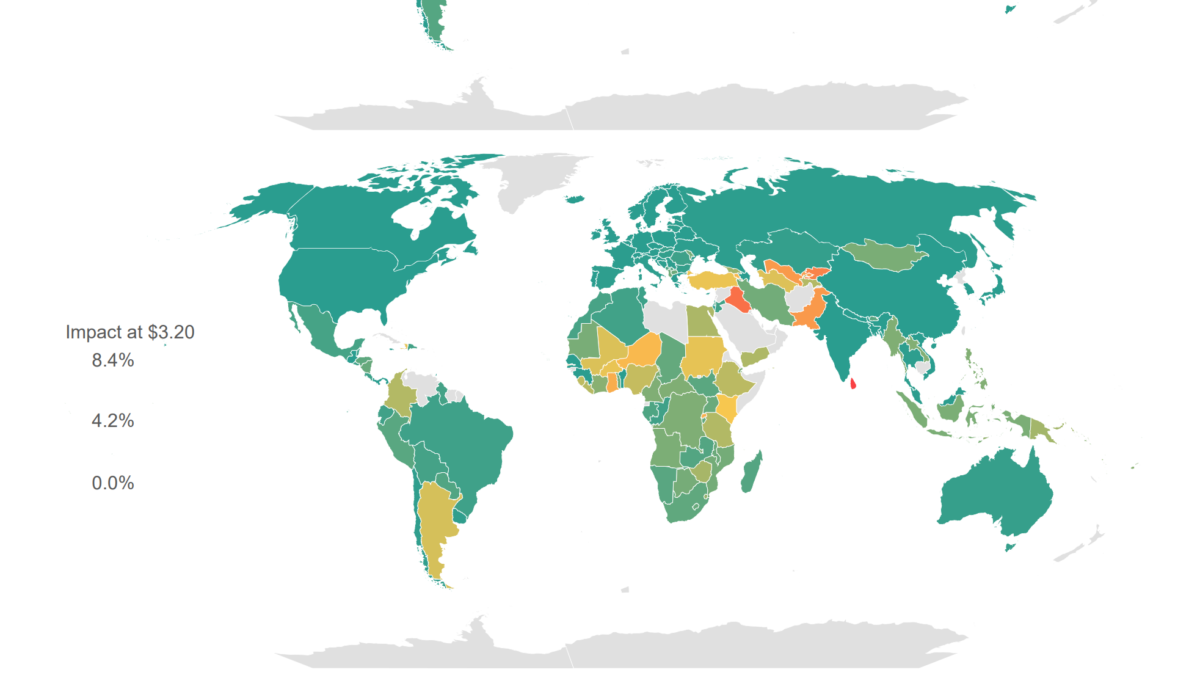U.S. mass killings linked to extremism spiked over last decade – “It is not an exaggeration to say that we live in an age of extremist mass killings”
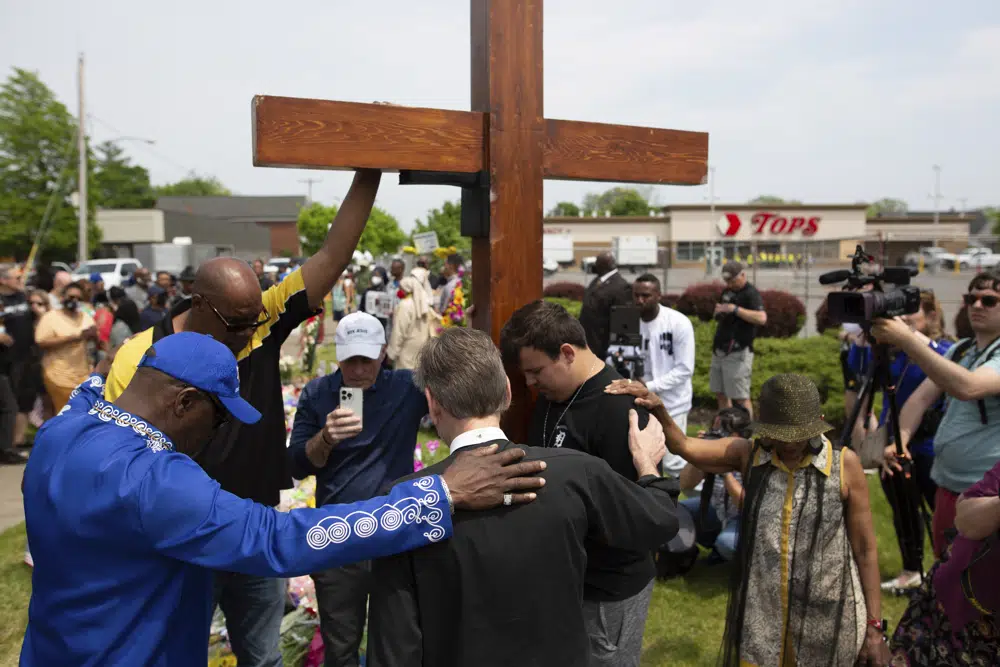
By Lindsay Whitehurst
23 February 2023
WASHINGTON (AP) – The number of U.S. mass killings linked to extremism over the past decade was at least three times higher than the total from any other 10-year period since the 1970s, according to a report by the Anti-Defamation League.
The report, provided to The Associated Press ahead of its public release Thursday, also found that all extremist killings identified in 2022 were linked to right-wing extremism, with an especially high number linked to white supremacy. They include a racist mass shooting at a supermarket in Buffalo, New York, that left 10 Black shoppers dead and a mass shooting that killed five people at an LGBT nightclub in Colorado Springs, Colorado.
“It is not an exaggeration to say that we live in an age of extremist mass killings,” the report from the group’s Center on Extremism says.
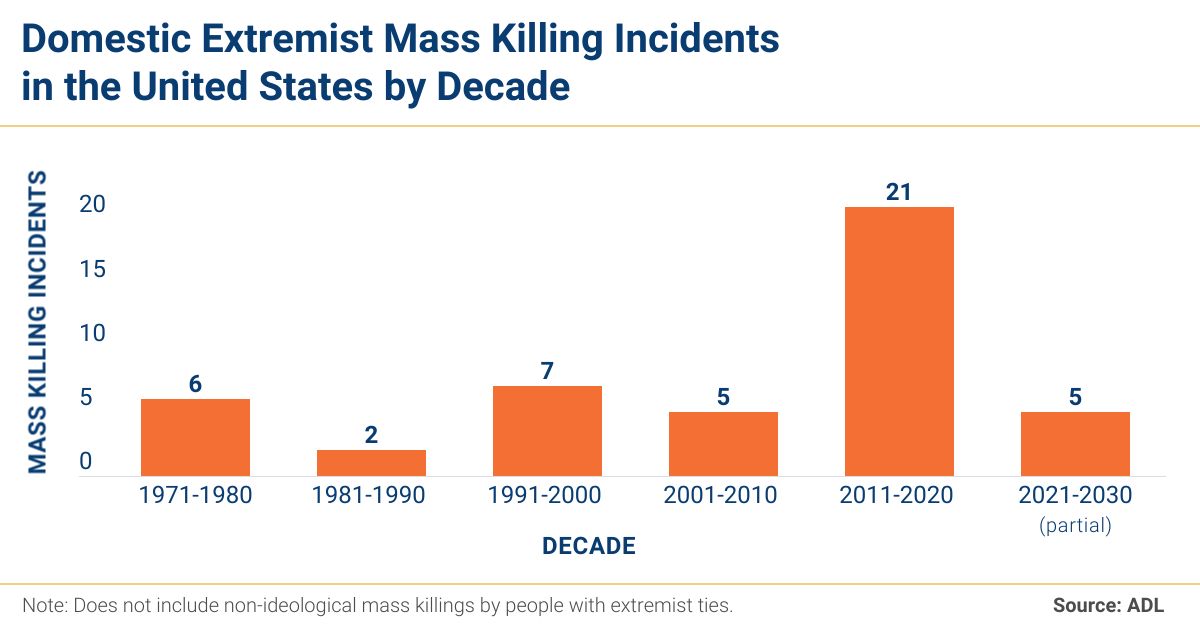
Between two and seven domestic extremism-related mass killings occurred every decade from the 1970s to the 2000s, but in the 2010s that number skyrocketed to 21, the report found.
The trend has since continued with five domestic extremist mass killings in 2021 and 2022, as many as there were during the first decade of the new millennium.
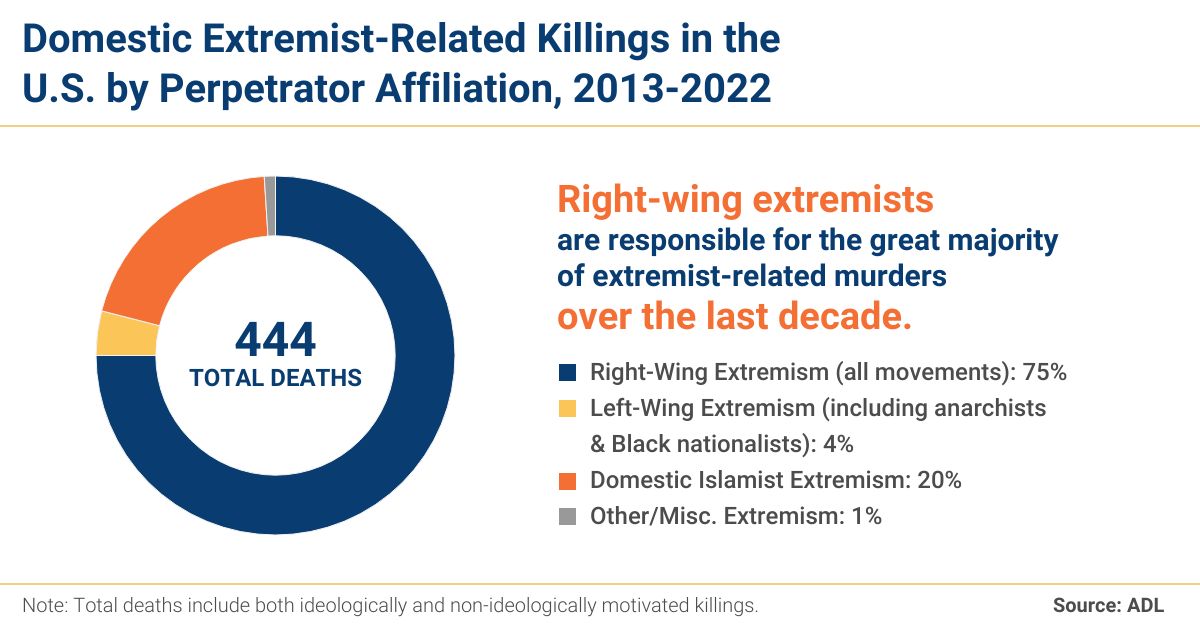
The number of victims has risen as well. Between 2010 and 2020, 164 people died in ideological extremist-related mass killings, according to the report. That’s much more than in any other decade except the 1990s, when the bombing of a federal building in Oklahoma City killed 168 people.
Extremist killings are those carried out by people with ties to extreme movements and ideologies.
Several factors combined to drive the numbers up between 2010 and 2020. There were shootings inspired by the rise of the Islamic State group as well as a handful targeting police officers after civilian shootings and others linked to the increasing promotion of violence by white supremacists, said Mark Pitcavage, a senior research fellow at the ADL’s Center on Extremism.
The center tracks slayings linked to various forms of extremism in the United States and compiles them in an annual report. It tracked 25 extremism-related killings last year, a decrease from the 33 the year before.
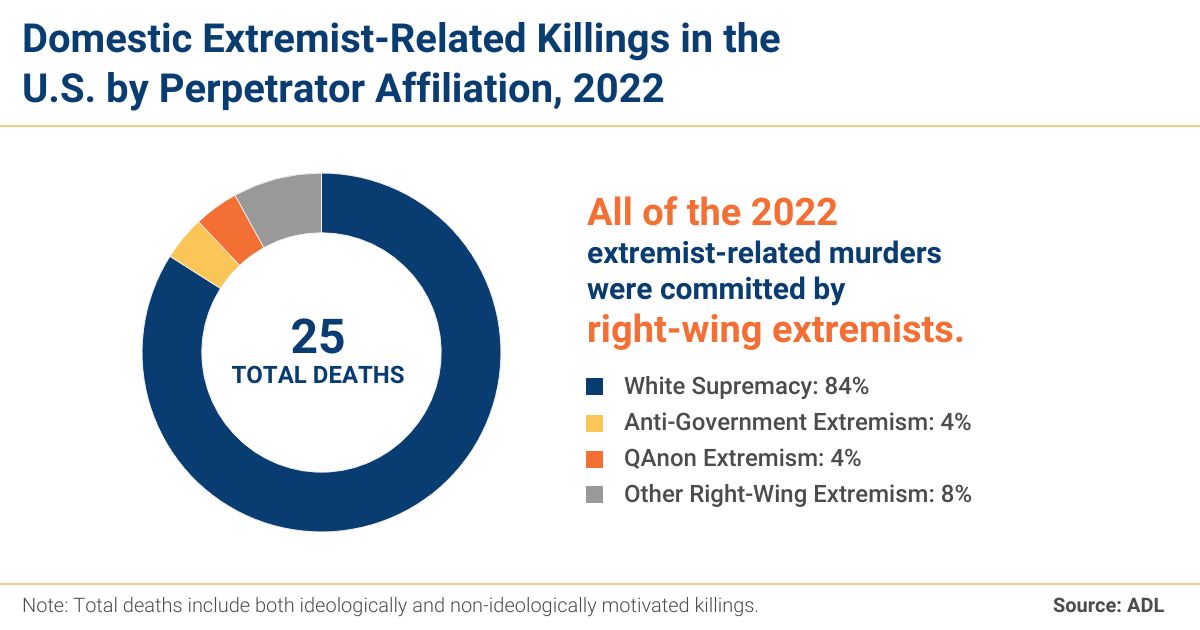
Ninety-three percent of the killings in 2022 were committed with firearms. The report also noted that no police officers were killed by extremists last year, for the first time since 2011.
With the waning of the Islamic State group, the main threat in the near future will likely be white supremacist shooters, the report found. The increase in the number of mass killing attempts, meanwhile, is one of the most alarming trends in recent years, said Center on Extremism Vice President Oren Segal.
“We cannot stand idly by and accept this as the new norm,” Segal said. [more]
US mass killings linked to extremism spiked over last decade
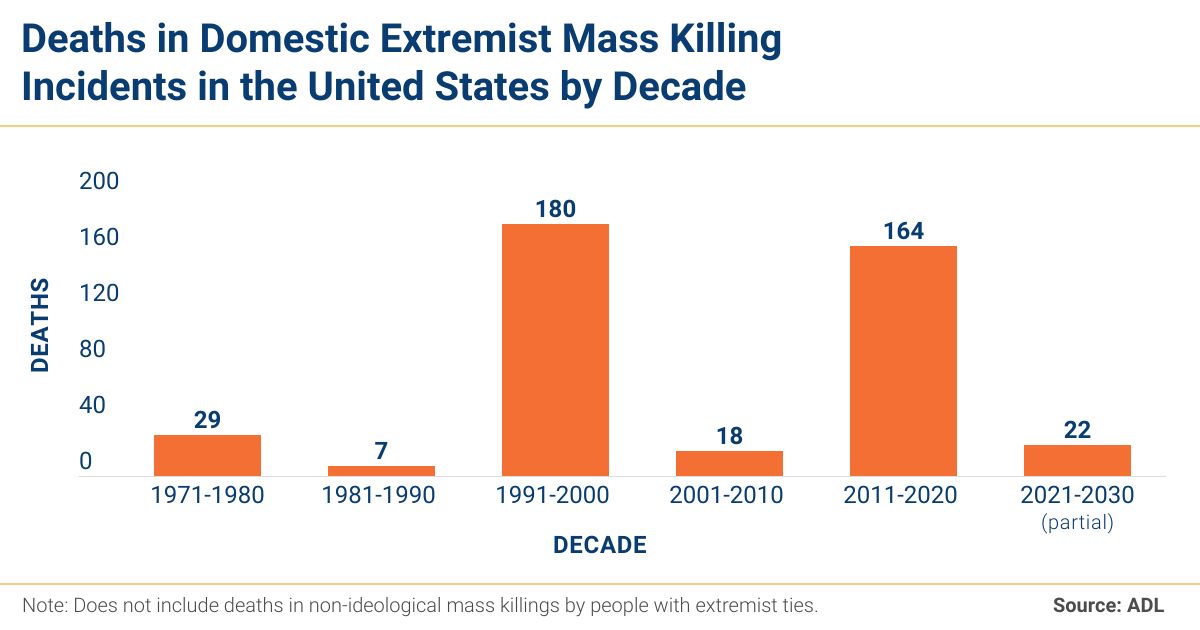
Murder and Extremism in the United States in 2022
22 February 2023 (ADL) – Executive Summary:
- Every year, individuals with ties to different extreme causes and movements kill people in the United States; the ADL Center on Extremism (COE) tracks these murders. Extremists regularly commit murders in the service of their ideology, in the service of a group or gang they may belong to, or even while engaging in traditional, non-ideological criminal activities.
- In 2022, domestic extremists killed at least 25 people in the U.S., in 12 separate incidents. This represents a decrease from the 33 extremist-related murders documented in 2021 and is comparable to the 22 extremist-related murders in 2020. It continues the recent trend of fewer extremist-related killings after a five-year span of 47-78 extremist-related murders per year (2015-2019).
- The 2022 murder totals would have been much lower if not for two high-casualty extremist-related shooting sprees. Only 10 of the 25 deaths occurred outside of those sprees—and one of those 10 deaths occurred in a less lethal mass shooting attempt.
- The issue of extremist-related mass killings is of growing concern and is the subject of a special section of this report. From the 1970s through the 2000s, domestic extremist-related mass killings were relatively uncommon. However, over the past 12 years, their number has greatly increased. Most of these mass killings were committed by right-wing extremists, but left-wing and domestic Islamist extremists were also responsible for incidents. The Center on Extremism has identified 62 extremist-connected mass killing incidents since 1970, with 46 of them being ideologically motivated. Disturbingly, more than half (26, or 57%) of the ideological mass killings have occurred within the past 12 years. Of particular concern in recent years are shootings inspired by white supremacist “accelerationist” propaganda urging such attacks.
- In 2022, 18 of the 25 extremist-related murders appear to have been committed in whole or part for ideological motives, while the remaining seven murders either have no clear motive or were committed for a non-ideological motive.
- All the extremist-related murders in 2022 were committed by right-wing extremists of various kinds, who typically commit most such killings each year but only occasionally are responsible for all (the last time this occurred was 2012). Left-wing extremists engage in violence ranging from assaults to fire-bombings and arsons, but since the late 1980s have not often targeted people with deadly violence. The same cannot be said for domestic Islamist extremists, but deadly incidents linked to Islamist extremism have decreased significantly in the U.S. over the past five years.
- White supremacists commit the greatest number of domestic extremist-related murders in most years, but in 2022 the percentage was unusually high: 21 of the 25 murders were linked to white supremacists. Again, this is primarily due to mass shootings. Only one of the murders was committed by a right-wing anti-government extremist—the lowest number since 2017.
Death and Extremism
Each year, individuals with ties to extreme movements and ideologies kill people in the United States. Some killings are high profile and spark nationwide outrage; others may go largely unnoticed except by families and friends of victims. Since 2008, the ADL Center on Extremism (COE) has worked to identify and track as many of these domestic extremist-related murders as possible, and to identify past extremist-related murders dating back to 1970.
Domestic extremists pose significant problems in the U.S., from incitement and harassment to hate crimes and terrorism, but reliable data can often be difficult to find and this can make it more difficult to understand or respond to issues related to extremism. Since 2015, COE has used its data on extremist-related murders to release annual reports on such killings to help people understand one of the most serious threats that extremists in the U.S. can pose: the taking of human life.
Domestic extremists—extremists who are U.S. citizens or longtime permanent residents—regularly commit murders to further their causes, using deadly force against perceived enemies. In addition, extremists also often commit murders in the service of a group or gang they may belong to—targeting a rival group member, for example, or even a suspected informant in their own ranks. Extremists can also commit murders while engaging in non-ideological criminal activities ranging from home invasions to domestic violence. In some cases, the motive for a particular murder connected to an extremist may never be discovered. We include all these types of killings in this report, as each is important for different reasons. The data we provide is transparent, so it is possible to distinguish ideologically motivated killings from other types.
Extremist murders in the U.S. in recent years have been committed by extremists from the far right, such as white supremacists or sovereign citizens, by domestic Islamist extremists, by left-wing extremists such as Black nationalists or anarchists and occasionally by people associated with other, more obscure causes or groups. All types are included in these annual reports if such killings occur. Each report also contains updated statistics from previous years, where applicable, as the extremist connections to some killings can take months or years to emerge. The discovery in April 2022 of possibly as many as 12 or more sets of human remains in Oklahoma buried on two sites, including property connected to a leader of the Universal Aryan Brotherhood, a large and violent white supremacist prison gang, graphically underscores this fact. At this point, it is not clear how many of the remains will be identified, how many of the killings will be solved or how many of them will be clearly linked to the UAB.1
It is important to note these statistics are just one metric of extremist violence and crime. Every year, extremists in the U.S. are involved in terrorist plots and acts, armed standoffs, shootouts with police, hate crimes, scams and cons, threats and harassment and a wide variety of other criminal acts. ADL’s regularly updated Hate, Extremism, Antisemitism and Terrorism (H.E.A.T.) map keeps track of some of the more serious of these extremist-related incidents, including murders but also terrorist incidents and shootouts, as well as other non-violent indicators, such as white supremacist events and propaganda distribution incidents.2
Domestic extremists killed at least 25 people in the U.S. in 2022. This represents a substantial drop from the 33 deaths COE has recorded for 2021 and is comparable to the 22 people murdered by extremists in 2020. The past three years have all seen fewer people killed at the hands of extremists than the five preceding years (2015-2019), when deaths ranged from 47 to 78 each year.
Still, the deaths for 2022 could easily have been much lower, as 60% of the murders came from just two incidents—deadly shooting sprees in Buffalo, New York, and Colorado Springs, Colorado. Absent these mass killings, there would have been only 10 extremist-related deaths in 2022. Most extremist-related killing incidents involve only a single victim, but in recent years a small number of extremist mass killers have caused a disproportionate number of the deaths.
Almost all the killings in 2022 (93%) were committed with firearms. This has been a consistent fact of extremist violence for years. Although many people may think of extremists as employing weapons such as bombs and explosives, it is firearms—plentiful, accessible and often laxly-regulated in the U.S.—that are actually the deadly weapon of choice for American extremists. Indeed, in each of the past five years over 80% of the victims of deadly extremist violence were killed with firearms, a consequence of the country’s failure to take meaningful action to deal with gun violence.
Extremist-related killings are rare relative to the total homicides in the U.S. each year. However, extremist killings can have a disproportionate impact on communities, or even the entire country, especially when they take the form of a hate crime or a terrorist attack.3 [more]
